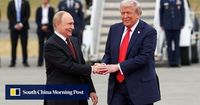Global oil markets have entered another volatile week, with prices swinging in response to high-stakes diplomacy and sharp rhetoric from world leaders. The latest moves come after a closely watched meeting between U.S. President Donald Trump and Russian President Vladimir Putin in Alaska on Friday, August 15, 2025—a summit that has rippled through energy and geopolitical circles alike.
In the immediate aftermath of the Trump-Putin meeting, oil prices exhibited pronounced sensitivity. According to Reuters, Brent crude futures initially rose 30 cents, or 0.46%, to $66.15 a barrel by 6:29 GMT on Monday, August 18, while U.S. West Texas Intermediate (WTI) crude was up 39 cents, or 0.62%, at $63.19. Yet, as Asian trading unfolded, the mood shifted. South China Morning Post reported that Brent crude slipped 32 cents, or 0.49%, landing at $65.53, with WTI down 23 cents to $62.57. Other sources, including Mitrade, noted Brent at $65.62 (down 0.4%) and WTI at $62.66 (down 0.2%) by 00:30 GMT. Such rapid fluctuations underscored how traders are hanging on every word and gesture from the world’s power brokers.
What’s fueling this volatility? It’s a potent mix of diplomatic signaling, sanctions suspense, and shifting alliances. At the heart of the story is Trump’s decision to pivot away from demanding an immediate Ukraine ceasefire, instead seeking what he described as a broader peace deal with Moscow. This approach was evident in his Alaska meeting with Putin, which, as Reuters and Mitrade both highlight, yielded no concrete deal to end the Ukraine war but did hint at a new phase of negotiation.
Trump’s softer tone on sanctions and tariffs has not gone unnoticed. Over the weekend, he signaled that he would delay imposing retaliatory tariffs on countries such as China and India—two of the biggest buyers of Russian oil—but warned that action could come within weeks if diplomatic progress stalls. On Friday, Trump told reporters, “I did not immediately need to consider retaliatory tariffs on countries such as China for buying Russian oil but might have to in two or three weeks,” according to Reuters. This calculated ambiguity has left markets guessing about the likelihood of further disruptions to Russian crude exports, a key variable in global pricing.
The United States’ stance on India’s oil trade with Russia has become another flashpoint. White House trade adviser Peter Navarro, writing in the Financial Times, was blunt: “India acts as a global clearinghouse for Russian oil, converting embargoed crude into high-value exports while giving Moscow the dollars it needs.” Navarro argued that if India wants to be treated as a strategic partner of the U.S., “it needs to start acting like one.” Such pointed criticism, paired with the postponement of trade talks, has revived concerns that energy flows remain hostage to diplomatic and trade frictions. Priyanka Sachdeva, a senior market analyst at brokerage Phillip Nova, told Reuters, “The U.S. adviser’s sharp words on India’s Russian crude imports, paired with postponed trade talks, revive concerns that energy flows remain hostage to trade and diplomatic frictions, even as peace prospects in Ukraine brighten.”
For now, the status quo persists, but the outlook is anything but settled. Helima Croft, an analyst at RBC Capital, observed, “The status quo remains largely intact for now,” adding that Moscow would not walk back its territorial demands, while Ukraine and some European leaders would likely balk at a land-for-peace deal. Trump, meanwhile, was scheduled to meet Ukrainian President Volodymyr Zelenskiy and European leaders in Washington on Monday, August 18, pressing Ukraine to accept a quick peace deal—a move that could reshape the balance of power in Europe’s deadliest conflict in 80 years.
Market reactions have been swift and, at times, contradictory. The initial rebound in oil prices after Navarro’s comments demonstrated just how fragile sentiment is. Any sign that Washington might tighten its stance on India’s Russian oil purchases quickly reintroduces a risk premium, as traders price in the possibility of supply disruptions. Yet, as Mitrade and South China Morning Post report, the easing of sanctions concerns following the Trump-Putin summit has, at least temporarily, kept downward pressure on prices. “Easing sanctions concerns and ongoing diplomacy are expected to keep downward pressure on oil until clearer outcomes emerge from negotiations,” Mitrade noted.
China’s role looms large in the background. As the world’s biggest oil importer and the largest buyer of Russian oil—followed closely by India—China’s purchasing decisions are pivotal. Trump’s threat of tariffs, though delayed, remains a wildcard that could upend established trading patterns if implemented. For now, however, both China and India continue to source significant volumes of Russian crude, helping Moscow maintain its war chest despite Western embargoes.
Investors are also keeping a close eye on the U.S. Federal Reserve, searching for clues about the path of interest rates that could influence everything from oil demand to stock market performance. Federal Reserve Chairman Jerome Powell is set to speak at the Jackson Hole meeting later this week, a key event for global markets. “It’s likely he will remain noncommittal and data-dependent, especially with one more payroll and Consumer Price Index (CPI) report before the September 17 FOMC meeting,” IG market analyst Tony Sycamore wrote in a note, as cited by Reuters.
Despite the flurry of diplomatic activity and market gyrations, the underlying issues remain stubbornly unresolved. The Alaska meeting between Trump and Putin did not produce a breakthrough on Ukraine, and both sides appear to be digging in on core demands. While Trump has touted “BIG PROGRESS ON RUSSIA” over the weekend, he has yet to offer specifics—a fact that has not gone unnoticed by market watchers and nervous diplomats alike.
For ordinary consumers and businesses, the stakes are high. Oil prices, after all, affect everything from gasoline at the pump to the cost of goods on store shelves. The current environment—marked by uncertainty, shifting alliances, and the ever-present threat of new sanctions or tariffs—means that volatility is likely to persist. As one analyst put it, energy flows remain “hostage to trade and diplomatic frictions,” and until a durable peace emerges in Ukraine, markets will continue to react to every hint of progress or setback.
As the week unfolds, all eyes will be on Washington, where Trump’s talks with Zelenskiy and European leaders could set the tone for the next chapter in both the Ukraine conflict and global energy markets. For now, the only certainty is that uncertainty itself remains the defining feature of the oil trade in 2025.





